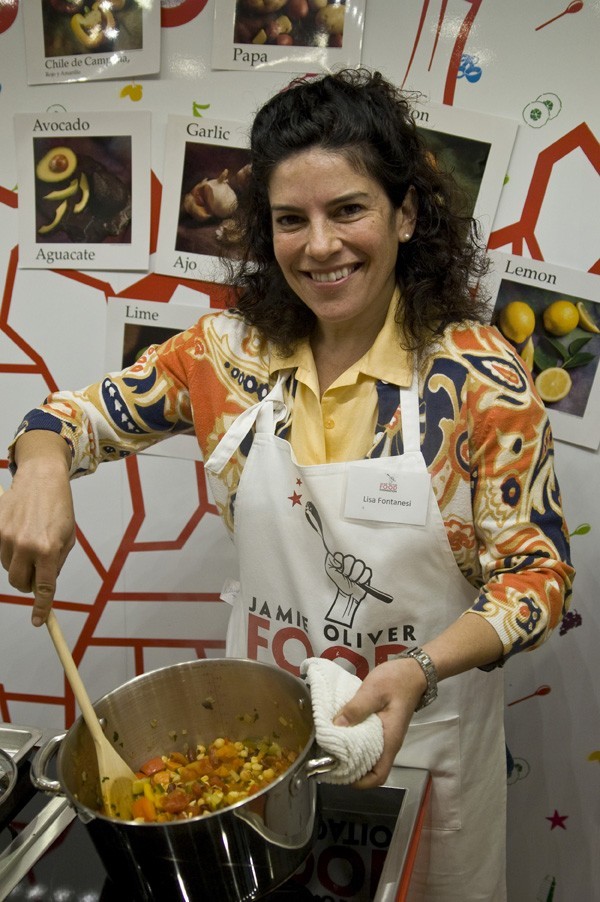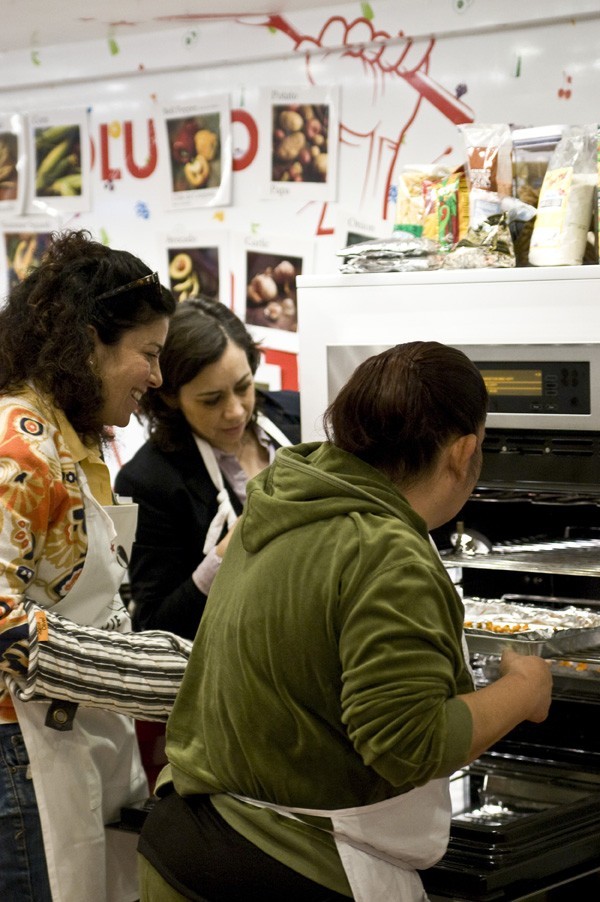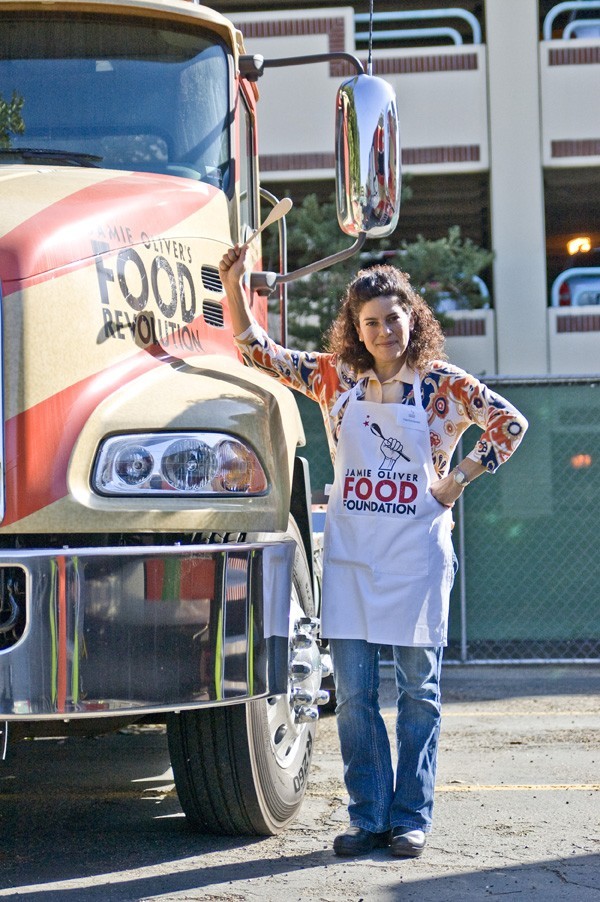
In Part One of our Q&A with Lisa Fontanesi, we learned about the mission of the Jamie Oliver Food Revolution, in particular how the Santa Ana community differs from the other places the mobile teaching kitchen has stopped. Today, we learn more about how our subject got started on her path in the first place.
Could you talk a little about your food background before you were hired to work for the foundation?
Sure, I'm a mom, and I'm a really good cook, but I'm not a trained chef. Seven years ago, I started my own company called Kidding Around the Kitchen. I started by working with the Hollywood farmers' market, doing demos for families by showing them how to get their kids involved in using fresh fruits and veggies at the farmers' market, how to shop with their children. That blossomed into teaching at a local elementary school in LA Unified School District; that blossomed into teaching in 15 different elementary and middle schools. I also do a family cooking event called Target Free Family Days at the Japanese-American Museum the second Saturday of every month.
The whole basis of what I was doing was to get families to cook together. My motto for kids is: If they cook it, they will eat it. Food is the one place in which kids have some power. They have the power to say no, but if you make it fun and they start to know what they're doing and have some power and choices, you can turn things around. They'll say yes and really try things they wouldn't otherwise. The other thing is: Don't dumb food down for kids because they're really smart.
]
That's a good segue into the mission of the Jamie Oliver Food Foundation, which is to work with families, in particular young people, to learn how to cook.
Exactly. In 2010, I got to go to the White House for the Chefs Move to Schools Initiative that First Lady Michelle Obama launched. That was really cool. That took me from having a cool little company to people paying attention to me. I did 10 healthy grilling videos for the Food Network on healthy cooking. I saw Jamie's first season in West Virginia for the Food Revolution and I said, “I want to meet this man. He needs to know what we're doing in Los Angeles, and I want to know what he's doing.” So I put it out to the universe.
The universe answered back. Someone said, “I know the director of the first season of the Food Revolution, and I'll introduce you when he comes out.” That was July 2010. Then, on one of the episodes, I dressed up like a carrot and Jamie dressed up like a tomato to talk to the kids about eating their fruits and vegetables and trying to make a difference in the food at school. Conversations happened about more classes, and I met lots of people from his entourage and staff. I didn't know where it was going to lead, but I kept showing up at meetings. I got a call about a year ago saying the truck was happening and they needed a program manager, and that's how it happened.
Last March, we did a test run of the food truck. We did it at the California Endowment, and we did it with a bunch of high-school students, and it was just great. Myself and one of the other assistant chefs did the class, and the next day, I was offered the position.

So you've had a pretty fantastic ride here. Is there some moment that you're most proud of in this path?
Just that people are getting it. There are three [such moments I had] in Santa Ana. There's the woman who said she labeled everything so her family can't miss it. Another woman went home and threw away all the other stuff in her pantry. Her husband said, “What are you doing? We can't do this; we're not rich,” and she said, “Yes, but we're not rich enough to have to be at the doctor all the time, so let's start fresh.” And just yesterday, there was an eighth-grader in our class who made this week's recipe, a shake and bake. Instead of a Filet-O-Fish sandwich, it's our own homemade version, and this 13- or 14-year-old boy said he hadn't eaten fish in seven years because he had a bad fish stick once. But he made it and ate it. He said, “It's actually good, and I'm not going to get sick because I know what's in it.” So that's the stuff, the little victories.
I don't think they're little moments. They're huge moments in someone's life, to say, “Hey, I actually kind of like fish.”
It's empowering people to believe they have control of their life and food. It's a way to bring families together, too. In this fast-paced world, we're all looking for ways to have a little time together.
Let's talk a little about the ways the classes work. How are they structured over the several weeks the classes run?
[
Our hosts, wherever we go, work through the Building Stronger Communities of the California Endowment. In Santa Ana, our host is Building Healthy Communities. They set up our classes for us, and they pick the groups. We have 20 groups a week, and each class is for an hour and half. Each group comes at the same time, on the same day, for a five-week period. So from 11 a.m. to 12:30 p.m. every Wednesday, we have the same group show up.

The class format is they show up on the truck, get aprons and name tags, and they wash their hands. We have a fresh fruit or vegetable — some sort of healthy quick snack. We found early on in our first stop that a lot of people step up on the truck hungry, and we don't get to eat our food for a good hour into the time on the truck; we don't want anyone to pass out on us or feel weak, so we always have something. It's a good conversation starter on healthy snacking anyway.
Then we go into a demo about what the lesson may be. In this five-week session, we're doing breakfast; snacks and light meals; fast food; ethnic cooking — native American and vegetarian stew based on the “three Sisters” [the California native crop of corn, beans and squash]. We'll be talking about whole grains and how to make a veg meal but still have it satisfying and full of protein. The last class is dinner, and that lesson plan is about how food has become so supersized: portions of distortion, we call it, or portion control. So we always have a some sort of nutrition lesson that goes along with whatever we're cooking.
After we go through a game on nutrition and the little demo on safety, we break into groups of 4:1 or 5:1 with an assistant chef/instructor, and we start cooking. We continue the conversation on whatever the lesson is about or whatever they want to talk about: food safety or knife safety. If they're adults, we get the adults used to the idea of incorporating their families into the cooking and the shopping. If we have kids, we talk about how to do this for their families and showing their parents or grandparents they can cook. That's one of the beauties of this program: We've been able to take the lesson and adapt to whatever group we have and tweak it a little bit without having to change much.
It seems like your focus is young people, families and novice cooks of whatever age. Is that accurate?
Absolutely, yes. We occasionally get people who say they wanted more, they wanted this or that. We have chefs on the truck who can give a little extra, but we're not Sur La Table. This is about getting novice cooks comfortable in their own kitchens and the idea of shopping and the idea of not always having to go from the box or the can or the fast-food restaurant, and making it fun along the way.
What would you say is the most important skill set or concept for novice cooks to learn?
Having confidence in your kitchen. Knowing when you're shopping, you know how to read your labels and understand what you're getting. Having a knowledge of food safety so you're not worried about getting someone sick with what you just made, and knowing how to be safe. Knowing you're not going to hurt yourself, and knowing how to equip your kitchen with a few tools you really need.
Is there something you want to tell us as a wrap-up?
This is Jamie's vision, and all of us — myself and all the other assistant chef/instructors — are just so happy. It really is a lovely program. I think we're really making a difference. In Long Beach and South-Central, the University of Southern California's Childhood Obesity Research Center did a study and collected empirical data through the Boys and Girls Club. We're waiting to see how the hands-on cooking classes can show actual results.
I'm just really happy to be part of something that I believed in anyway, and now we're reaching more people. We just have an amazing staff of people who really care. We're a model. We came out of nowhere, and we want to keep this program growing. I think we're on the right track.
Come back tomorrow for a Jamie Oliver recipe used on the Food Revolution truck!
Follow Stick a Fork In It on Twitter @ocweeklyfood or on Facebook! And don't forget to download our free Best Of App here!

